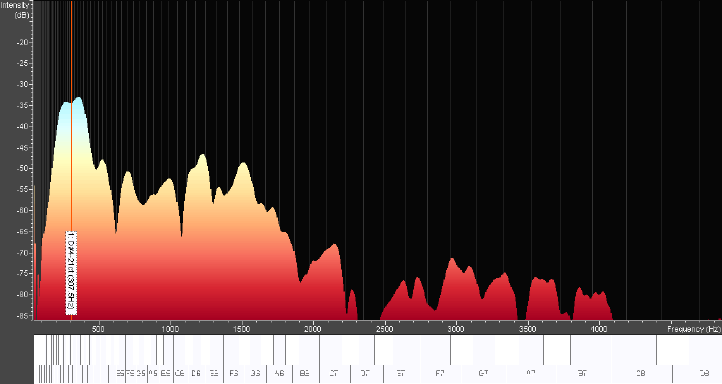'Nut' Adjustment so that your open strings match your fingered notes...
...The 'Nut' is the small ebony wood block at the peg box end of the fingerboard. It supports the end of the vibrating string and the string groove is shaped in such a way that it allows the strings to 'fall away' toward the peg box and hold each string at the correct height over the fingerboard. The wood grain goes in the direction of 'across the instrument'. The ebony wood is strong enough to keep the string from wearing a groove in the wood.
...The vibrating string interacts with the nut and then its' vibration is reflected back up the string. It is important that the frequency of the wood block (the nut), where the string contacts it, is the same as the frequency of the fingerboard under that same string, as well as equal to the tap tone frequency of the string bar of the tailpiece. That way the open strings will have the lowest response time, as well as the same strength of power and tone, as the fingered string notes. When these conditions exist, then the maximum power and clarity will be developed by the instrument and the open string notes can be substituted without obvious differences to the listener.
...The nut needs to be acoustically adjusted at each string position, so that the open strings sound the same as the fingered note on the next lower toned string. Adjustment is straight forward:
...The necessary tools are: a small flat tapered jewler's file with one side absolutely smooth, and perhaps a sharp pocket knife, and some blue masking tape to protect the adjacent varnish (use little pressure when applying the tape or the varnish might be lifted when the tape is removed.
...If the downward tap (tap tone) at the string contact point (of a particular string) is too low, then scrape or file some material from 'front' side of the nut, under that string until it matches (227 1/2) HZ. If both strings on that side are too low in tap tone, then the outside end can be shortened to raise both.
...If the tap is too high, then file or sand some material from the top shape near the string contact point.
...In listening to the tap tone, identify the lowest overtone in the tap sound and then use that to decide how to adjust. {Listen to our tap tone recording as your guide..." tap tones at your fingertips"}
..the vertical tap tone at both sides of the string contact need to match each other and (227 1/2) HZ, so each side is tuned separately.






Fingerboard in side profile
Nut
Remove material here (beneath the string you want to adjust) to raise the frequency at the string contact point. Listen for highest points and remove that material first.
String contact point.
...This is the sound specturm from a tap on one plate of a recent violin, and will serve as an example of what a tap tone is composed of and what we are to listen for:
...On the left is sound level in Db; on the bottom you see the frequencies {In Hertz (HZ) or vibrations per second} generated by a tap in the center of the top plate of my Opus #22 violin. The first prominent sound peak is the 'fundamental tap tone' that we are to be listening for. However, our wonderfully designed ears (brain, nerves, etc.) hear all these generated sound frequencies at once. The highest pitches (in this case 4,000 hertz, vibrations per second) is the easiest for your ears to hear, as our hearing is more sensitive to high frequency sound. However, the 'fundament' tap tone is the first major peak and this is the tap tone frequency that we want to hear and compare.
Unless I am mistaken, the nut and fingerboard should have matching tap tone frequencies of (227 1/2) HZ and (227 1/2) HZ respectively.


..File material from the top surface, around the string to lower that individual string tap frequency at the nut. {tiny amounts of wood removal as it has a large effect, so do this in small adjustments.
(Revised 12/2020)
(Page AA_7)
Neck in cross section...

















